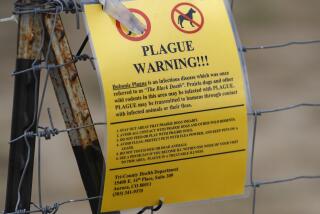Mother Nature Remains One Up on the Bioterrorists
- Share via
BOSTON — On Fox TV earlier this month, host Bill O’Reilly asked whether the recent spate of cruise ship epidemics could have been “bacterial sabotage.” In doing so, he voiced a common fear in our new age of global terrorism. But that tabloid-fed hypothesis is dangerously easy and ignores century-old lessons of public health.
Suspicions about bioterrorism are understandable. After all, a bona fide act of bioterrorism -- the anthrax attacks of 2001 -- remains unsolved. The largest previous case of bioterrorism in the United States, in which 751 Oregon salad bar patrons came down with salmonella food poisoning in 1984, went unsolved for a year until a religious cult member questioned on unrelated matters unexpectedly confessed to the crime.
But the culprit in the cruise ship outbreaks, Norwalk virus, is one of the most infectious and contagious germs around. It doesn’t need deliberate human assistance to spread; like the common cold, it gets around quite well on its own.
Indeed, Norwalk virus and its close relations are the most frequent cause of food-borne illness in this country, responsible for an estimated 23 million cases each year. So hardy and transmissible is the virus that it stars in two classic episodes in the modern annals of public health.
In 1998, the virus scored big at a college football game between Duke and Florida State. The Duke players had eaten Norwalk-contaminated food at their training center before traveling to Tallahassee for the game. Around kickoff time, they started to suffer the same graphic symptoms as the hapless cruise ship vacationers. By the end of the game, 64 players from both teams were infected.
An even more dramatic outbreak took place in 1982, when a Minnesota bakery worker ill with Norwalk virus used his bare hands and arms to stir a batch of butter-cream frosting. This unusual culinary technique left some 3,000 pastry lovers in gastronomic distress.
If the recent cruise ship epidemics demonstrate anything, it’s how modern life -- not malign saboteurs -- gives emerging pathogens entree to new niches around the globe and inside our bodies. So many aspects of our culture -- from where we live to where we play, from how we raise livestock to how we raise children, from invasive medical technologies to high-speed transportation -- are changing in ways that create more intersections between us and the bugs.
Vacation cruises, we now know, are perfect breeding grounds for Norwalk virus, the flu virus and other organisms. Building new homes amid second-growth forests has given us Lyme disease. Lifesaving chest catheters have spread drug-resistant Staphylococcus bacteria. Global travel has brought old scourges like mosquito-borne yellow fever and malaria to our shores. And yet it’s also true that, against this backdrop of ever-emerging infections, an intentionally planted epidemic might be hard to distinguish from a natural disease outbreak.
Today more than ever, public health officials are primed to take notice if lots of people suddenly become ill from a single disease agent or suffer pulmonary symptoms (suggesting an aerosolized microorganism or toxin); if large numbers of victims are afflicted with a pathogen not previously seen in their geographic area; or if several deadly epidemics erupt simultaneously. But these same criteria also describe recent high-profile outbreaks with natural causes -- outbreaks that looked at first like bioterrorism but proved not to be.
The 1976 epidemic of a fatal respiratory infection at an American Legion convention in Philadelphia, for instance, had all the hallmarks of a deliberate chemical or biological attack -- especially because it took months to identify the bacterium that caused what we now know as Legionnaires’ disease.
HIV/AIDS in Africa in the 1980s, dengue fever in Cuba in 1981, pneumonic plague in India in 1994, foot-and-mouth disease in hogs in Taiwan in 1997, Nipah virus among animals and humans in Malaysia and Singapore in 1998, West Nile virus in New York City in 1999, foot-and-mouth disease in Britain and Europe in 2001: All at some point were suspected of having been deliberately introduced.
Precisely because charges of bioterrorism are so easily hurled today, we need a robust global public health system that can protect against both natural and premeditated epidemics. A few days before O’Reilly’s show, the World Health Organization launched an emergency fund to dispatch aid within 24 hours anywhere large-scale infectious disease breaks out, whether naturally spawned or intentionally sown. Fittingly, the fund’s seed money came from the Nuclear Threat Initiative, Ted Turner and former Sen. Sam Nunn’s charitable group working to halt global trafficking in weapons of mass destruction. The group’s rationale for the contribution: The same measures needed to defend against and defuse bioterrorism are those needed to contain normally evolving infections that can swiftly turn into global nightmares.
Bioterrorism is a growing peril. As the number of people with expertise in microbiology and molecular biology increases, so will the small fraction willing to use their skills to destructive ends. But the recent cruise ship outbreaks, however distressing to those on board, shouldn’t raise undue suspicions or skew our perspective.
In nations where the populace cannot afford cruises, infectious disease stubbornly ranks as the top killer. Despite today’s headlines, the most talented bioterrorist remains nature itself.


